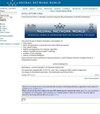mlp中隐藏层节点数的上界
IF 0.9
4区 计算机科学
Q4 COMPUTER SCIENCE, ARTIFICIAL INTELLIGENCE
引用次数: 0
摘要
隐层节点数的确定是神经网络中最基本、最具挑战性的问题之一。对于某些特定神经网络,如具有特定或条件激活函数的单隐藏层和双隐藏层前馈神经网络,人们已经做了各种努力来研究其逼近能力与隐藏节点数之间的关系。然而,对于任意前馈神经网络,这方面的理论研究却很少。本文从代数的角度给出了最一般的前馈神经网络多层感知器(MLP)的每个隐藏层节点数的上界。首先,我们提出了扩展线性空间的方法来研究mlp输出的代数结构和性质。然后证明了给定k个不同的训练样本,对于每一隐层有k个节点的任意MLP,如果某个优化问题有解,则随着隐层节点的增加,逼近误差保持不变。进一步表明,对于任何输出层激活函数有界于R的MLP,每个隐藏层中最多需要k个隐藏节点来学习k个训练样本。本文章由计算机程序翻译,如有差异,请以英文原文为准。
Upper bounds on the node numbers of hidden layers in MLPs
It is one of the fundamental and challenging problems to determine the node numbers of hidden layers in neural networks. Various efforts have been made to study the relations between the approximation ability and the number of hidden nodes of some specific neural networks, such as single-hidden-layer and two-hiddenlayer feedforward neural networks with specific or conditional activation functions. However, for arbitrary feedforward neural networks, there are few theoretical results on such issues. This paper gives an upper bound on the node number of each hidden layer for the most general feedforward neural networks called multilayer perceptrons (MLP), from an algebraic point of view. First, we put forward the method of expansion linear spaces to investigate the algebraic structure and properties of the outputs of MLPs. Then it is proved that given k distinct training samples, for any MLP with k nodes in each hidden layer, if a certain optimization problem has solutions, the approximation error keeps invariant with adding nodes to hidden layers. Furthermore, it is shown that for any MLP whose activation function for the output layer is bounded on R, at most k hidden nodes in each hidden layer are needed to learn k training samples.
求助全文
通过发布文献求助,成功后即可免费获取论文全文。
去求助
来源期刊

Neural Network World
工程技术-计算机:人工智能
CiteScore
1.80
自引率
0.00%
发文量
0
审稿时长
12 months
期刊介绍:
Neural Network World is a bimonthly journal providing the latest developments in the field of informatics with attention mainly devoted to the problems of:
brain science,
theory and applications of neural networks (both artificial and natural),
fuzzy-neural systems,
methods and applications of evolutionary algorithms,
methods of parallel and mass-parallel computing,
problems of soft-computing,
methods of artificial intelligence.
 求助内容:
求助内容: 应助结果提醒方式:
应助结果提醒方式:


